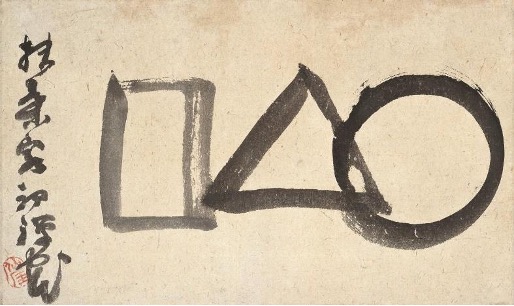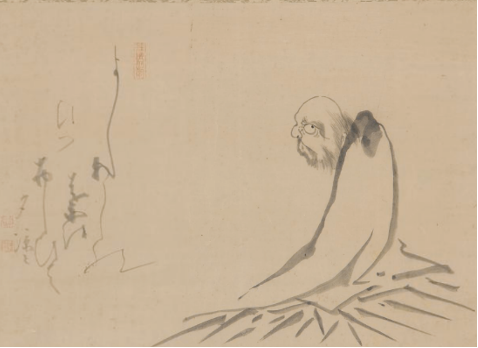

‘What is the sound of one hand clapping?’ – Hakuin Ekaku (1686–1769)
This enigmatic kōan, posed by Zen master Hakuin Ekaku, captures the essence of Zen Buddhism: a path to enlightenment through paradox, simplicity and direct experience. These teachings gave rise to Zenga – a distinctive school of ink painting practised by Zen monks in Japan.
Zen Buddhism first arrived in Japan from China, introduced by the Indian monk Bodhidharma (Daruma) in the 6th century. It was a reaction to the ritual-heavy practices of older Buddhist schools and promoted a personal journey to satori (awakening) through meditation, discipline and direct pupil-master relationships.
Zen’s simplicity resonated particularly with the samurai class. Its influence on Japanese culture was far-reaching, shaping everything from architecture and garden design to pottery and painting. Zenga, or Zen painting, is one of its most powerful artistic expressions.
Derived from Chinese literati traditions of the Song and Yuan dynasties, and inspired by the expressive brushwork of 13th-century Hangzhou monks, Zenga painting prioritises inner truth over visual perfection. A single brushstroke or poem might contain profound spiritual insight. As Buddha reminded his followers, the finger pointing at the moon is not the moon itself. The work is merely a guide – the experience is internal.
Among the works offered this season is a calligraphy painting by Daishin Gito (1657–1730), a senior Rinzai Zen priest and 273rd abbot of Daitokuji Temple in Kyoto.
Daishin Gito (1657 – 1730), Edo period, 17th / 18th Century, Three Jewels of Buddhism, ink on paper, inscribed, sealed and signed, 32cm high, 50cm long, from an English private collection of Zen paintings, ex collection of Daikokuji temple. Lot 315 in Asian Art I estimate of £400 - £600
Also included is a meditative ink composition by Sengai Gibon (1750–1837), 123rd abbot of Shōfukuji Temple. Gibon’s works are known for their humour and humility. His paintings often carry messages that challenge dualistic thinking, as seen in this poetic example:
“Relying upon a finger, we see the moon
Relying upon the moon, we understand the finger.
Moon and finger are neither the same nor different…”
– Ryōkan Taigu (1758–1831)
Sengai Gibon (1750 – 1837), Village Hut Edo period, circa 1800, ink on paper, sealed and signed 56cm high, 24cm long, from an English private collection of Zenga. Lot 313 in Asian Art I, with an estimate of £500 -£700.

Sengai Gibon (1750 – 1837), The Universe, Smithsonian's National Museum of Asian Art, accession no S2012.9.4606
A pupil of Tōrei (himself a follower of Hakuin Ekaku), Taikan Monju’s depiction of Daruma draws directly on the lineage of Zenga’s great masters. His use of pun and symbolism reveals a deep understanding of Zen teaching.
Taikan Monju (1765 - 1842), Daruma on a Reed, Edo period, 18th / 19th Century, ink on paper, inscribed, sealed and signed, 48cm high, 40cm long, from an English private collection of Zenga. Lot 314 in Asian Art I, with an estimate of £800 -£1200
.
Hakuin Ekaku (1686 – 1769), Daruma on a Reed Edo period, 18th / 19th Century, Smithsonian's National Museum of Asian Art, accession no FSC-PA-191
A particularly engaging example in this sale is by Nakahara Nantenbō (1839–1925). Both a reformer and teacher, Nantenbō played a central role in the revival of Rinzai Zen and the modernisation of Zenga in the 20th century.
These charming scenes of itinerant monks reflect the artist’s interest in the spiritual journey of the practitioner. They were acquired in the 1990s from Hiroshi Yanagi at Tokyo Gallery, Kyoto.
Nakahara Nantenbō (1839 – 1925), Monks Setting Out and Monks Returning, Taisho period, circa 1922, a pair of Japanese hanging scroll paintings, kakejiku, ink on paper, each signed and sealed, 5cm high, 30.5cm long, from an English private collection, acquired from Hiroshi Yanagi at Tokyo Gallery, Kyoto in the 1990s. Lot 312 in Asian Art I, with an estimate of £800 - £1200.
Since the Meiji period, Zenga has fascinated collectors and institutions alike. Works by Sengai and Nantenbō are now held in leading museum collections, including the Smithsonian, the Gitter-Yelen Collection in San Francisco, and the Kaeru-An Collection in Amsterdam. Most recently, pieces from the latter were exhibited at the National Museum in Prague in 2022, cementing Zenga’s place as one of Japan’s most widely appreciated art forms internationally.
We are excited to feature a selection of examples from these famous monk masters to form part of our 19th of May Asian Art I sale. View the full auction catalogue.
Get in touch with our Asian Art department at asian@chiswickauctions.co.uk or submit an online valuation.